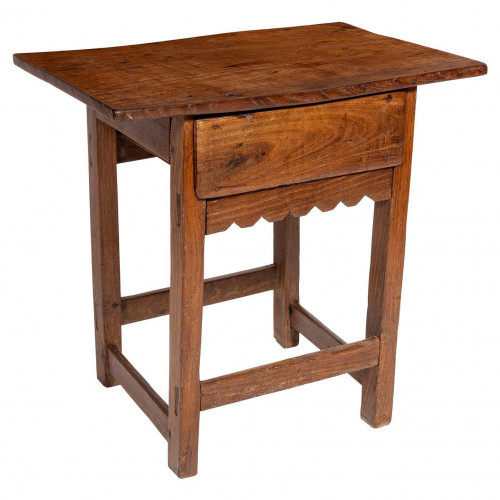A pair of late-19th century, upholstered, coffermakers armchairs
10143
Upholstered in the original green velvet faced with braid and fringe. This model of armchair is based on a group of 17th century chairs at Knole in Kent. A similar chair is illustrated in English Chairs, published by the Victoria & Albert Museum, 1970, figure 12, formerly in the possession of William Juxon (d1663), Archbishop of Canterbury.
The coffermakers were normally producers of dome-lidded trunks, hence the name coffers. Their form of construction, in which a wooden framework is entirely covered with nailed textile or leather was also applied by this trade to this particular model of chair (see also an article by R W Symmonds Coffer Makers and Upholsterer's Chairs, The Antique Collector, Jan/Feb 1950, pp 19/25.
19th Century
1875
Oak & velvet
England
The late John Paul Getty Collection, Sutton Place. Inventory Number C19FRN/248/AT/2. The great renaissance mansion of Sutton Place was the creation of Sir Richard Weston, Henry VIII's loyal and influential courtier. Shrouded in mystery and romance, it is reputed that Anne Boleyn and the King first met in this house, Sir Richard's son lost his head for his closeness to this most tenacious of Henry's wives. The early Tudor house was constructed between 1521 and 1533 in red brick, and in the newest style, most clearly evident in its symmetrical plan and the use of terracotta in the decorative Italianate panels and the window mullions. Probably constructed by the same builders that had worked on Hampton Court, the house has lost its north range and gate house, which, before 1782 completed the courtyard. Sutton Place remained in Weston ownership until the end of the 19th century after which it passed through a succession of owners, from the press baron Alfred, Lord Northcliffe and George, 5th Duke of Sutherland, to the American millionaire John Paul Getty who died in the house in 1976. Each successive owner has left his mark on the building, from the Tudor ceiling and panelling created for Mr Getty to the recently created antiquarian library. Each owner has filled its spaces with interesting and ecclectic furniture, specifically oak and walnut which harmonises so subtly with its period interiors.










